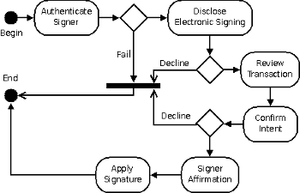Docusign commemorates ESIGN anniversary by launching new e-signature tools
Exactly ten years ago — on 30 June 2000 — President Bill Clinton signed the Electronic Signatures in Global National Commerce (ESIGN) Act, which aimed to encourage the use of e-signatures on business documents; to commemorate the anniversary, Docusign, a provider of an e-signature platform, is releasing of Docusign Spring 10, a major upgrade to its service

The typical e-signature authentication process is enhanced by Docusign // Source: esignaturepost.com
Signing documents for buying or selling a house, taking out a loan, or finalizing a sales agreement can be a tedious process involving sign one’s name over and over and over again.
There is a better way — and Sam Diaz writes in ZDNet that it has been around for ten years now. It was on 30 June 2000 that then-President Bill Clinton signed the Electronic Signatures in Global National Commerce (ESIGN) Act.
To commemorate the occasion, Seattle, Washington-based Docusign, a provider of an e-signature platform, is releasing of Docusign Spring 10, a major upgrade to its service. It is adding things like voice biometrics as another method of identity confirmation and Agent role, a tool that allows a real estate agent, for example, to manage and review documents for a client and then submit them.
It is also taking the product beyond just an electronic signature. In a statement, founder and chief strategy officer Tom Gonser said:
With this release, DocuSign is changing what companies expect from an electronic signature service. It’s not just about getting a signature anymore; it’s about a robust platform that manages the entire process — authentication, workflow, form data collection, collaboration, signing and secure storage.
Diaz writes that Docusign Spring 10 includes new collaboration tools, such as version management — where revisions can be made to a document, signed-off by all parties and show up for final sign-off as a clean copy. It also includes a new voice biometrics feature, which is another layer of identity confirmation.
It has also added an “Agent Role,” allowing, for example, a real estate agent the ability how to access and review files on behalf of the client, releasing them to the client only when they’re truly ready.
The company also is announcing a partnership with Box.net to bring DocuSign’s eSignature service essentially to finish out the full collaboration process — all the way down to the signing of the docs - to the cloud.
A recent Harris Interactive poll, commissioned by Docusign, found that Americans want to end the use of paper and “Go Green” when it comes to things like contracts. Of those polled, 72 percent said forms were too difficult to write in while 38 percent said it was too inconvenient to return signed paper docs via fax or mail. While nearly all of the respondents — 96 percent —agreed that their handwritten signatures were important parts of their identities, 66 percent said they with they could complete and sign certain forms online. Among them: employment and HR records, insurance documents, school forms, business contracts, medical forms, and real estate documents.
Steve King, president and CEO of Docusign, said:
This survey reflects the changing behaviors among adults across the United States and their desire to complete and sign documents online to be more productive and environmentally friendly. DocuSign is seeing a tipping point of adoption of our web-based electronic signature service, and as a company we’ve processed roughly 80 million transactions to date. Consumers who use the service for the first time to secure a loan, sign real estate documents and manage other paperwork are usually surprised as to how intuitive DocuSign is and how closely it replicates the experience of signing documents the old-fashioned way, but without the delays and hassles of paper.
